Basic massage techniques are foundational methods used to promote relaxation, relieve muscle tension, and improve overall well-being. These techniques, such as Swedish strokes and manual manipulations, are designed to enhance circulation, reduce pain, and restore mobility. Understanding proper body mechanics and manual dexterity is essential for effective and safe practice. Whether for therapeutic or holistic purposes, mastering these techniques provides a versatile approach to addressing physical and emotional health.
What Are Basic Massage Techniques?
Basic massage techniques are hands-on methods used to manipulate soft tissues, aiming to relieve tension, improve circulation, and promote relaxation. Common techniques include Effleurage (long gliding strokes), Petrissage (kneading), Tapotement (percussion), and Friction (deep tissue work). These methods are foundational in Swedish massage and are adapted to address specific needs, such as pain relief or muscle relaxation. Manual tools and guidelines ensure safe and effective practice, while contraindications are considered to avoid harm. These techniques form the core of many therapeutic approaches, emphasizing the scientific manipulation of tissues for wellness.
Benefits of Learning Basic Massage Techniques
Learning basic massage techniques offers numerous benefits, including enhanced physical and mental well-being. These methods reduce muscle tension, improve circulation, and promote relaxation, aiding in pain relief and stress reduction. By understanding proper body mechanics and manual manipulations, practitioners can address specific complaints effectively. Massage also fosters emotional connection and trust, making it a valuable skill for both personal and professional use. Regular practice can lead to improved posture, reduced anxiety, and a deeper understanding of the body’s responses to touch and pressure.
History and Evolution of Massage Therapy
Massage therapy has ancient roots, with evidence of its use dating back thousands of years in civilizations such as China, Egypt, and Greece. Early practices often combined manual techniques with spiritual and medicinal rituals. Over centuries, massage evolved, incorporating new methods and philosophies from various cultures. The modern era saw the formalization of techniques like Swedish massage in the 18th century, followed by advancements in deep tissue and trigger point therapies. Today, massage is a global practice, blending traditional and contemporary approaches to address physical and emotional well-being.
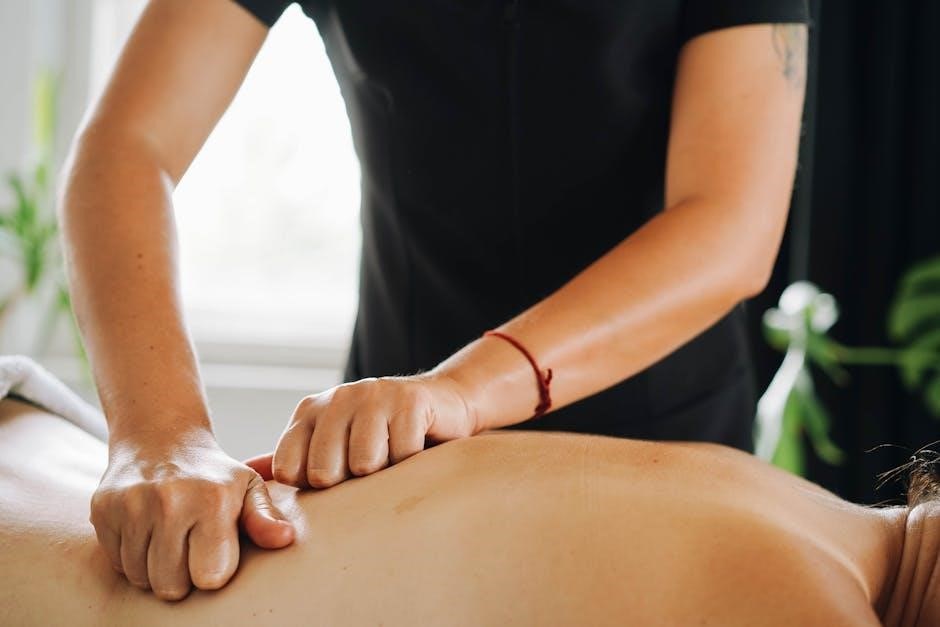
Swedish Massage: The Foundation of Basic Techniques
Swedish massage is a foundational technique emphasizing long strokes, kneading, and rhythmic tapping to promote relaxation, improve circulation, and ease muscle tension, forming the basis of many therapies.
Effleurage: The Long Gliding Stroke
Effleurage is a fundamental Swedish massage technique characterized by long, flowing strokes. Using the palms of the hands, therapists apply gentle to moderate pressure to glide over the skin. This stroke is designed to warm up muscles, improve blood circulation, and promote relaxation. It is typically performed in the direction of blood flow, aiding in lymphatic drainage and reducing muscle tension. Effleurage creates a soothing rhythm, making it an excellent starting point for any massage session to prepare the body for deeper work.
Petrissage: Kneading Techniques
Petrissage involves kneading movements that target specific muscle groups to release tension and enhance flexibility. This technique uses lifting, pressing, and squeezing motions to manipulate soft tissues. It is particularly effective for relieving deep-seated muscle knots and improving circulation. Petrissage can vary in intensity, from gentle rolls to deeper pressures, depending on the client’s needs. Regular use of this technique helps break down adhesions and promotes relaxation, making it a valuable component of therapeutic massage sessions for overall muscle health and well-being.
Tapotement: Rhythmic Percussion
Tapotement involves rhythmic percussion strokes that stimulate muscle tissue and enhance circulation. Techniques include light tapping, cupping, and hacking, creating a soothing yet invigorating effect. This method helps relieve muscle tension, improves lymphatic drainage, and boosts energy levels. Tapotement is often used in Swedish and sports massages to prepare muscles for deeper work. Its rhythmic nature can create a meditative experience, promoting relaxation and reducing stress. Proper application ensures comfort, making it suitable for various therapeutic and wellness-focused massage sessions.
Friction: Deep Tissue Work
Friction is a deep tissue technique that involves applying targeted pressure to specific areas. It uses slow, controlled strokes to address scar tissue, adhesions, and muscle fibers. This method is particularly effective for relieving chronic pain, improving circulation, and restoring mobility in tight or injured muscles. Friction is often used in therapeutic settings to break down restrictive tissue and promote healing. When applied correctly, it enhances flexibility and reduces muscle tension, making it a valuable tool in deep tissue and sports massage practices.
Stroking: Soft and Soothing Movements
Stroking is a gentle, rhythmic technique that involves light, flowing movements across the skin. These soft strokes are designed to create a calming and relaxing experience, promoting deep relaxation and reducing stress. Often used in Swedish massage, stroking helps to warm up the muscles, improve circulation, and prepare the body for deeper work. This technique is particularly beneficial for sensitive areas and can be adapted to suit individual preferences, making it a versatile and comforting element of basic massage therapy.
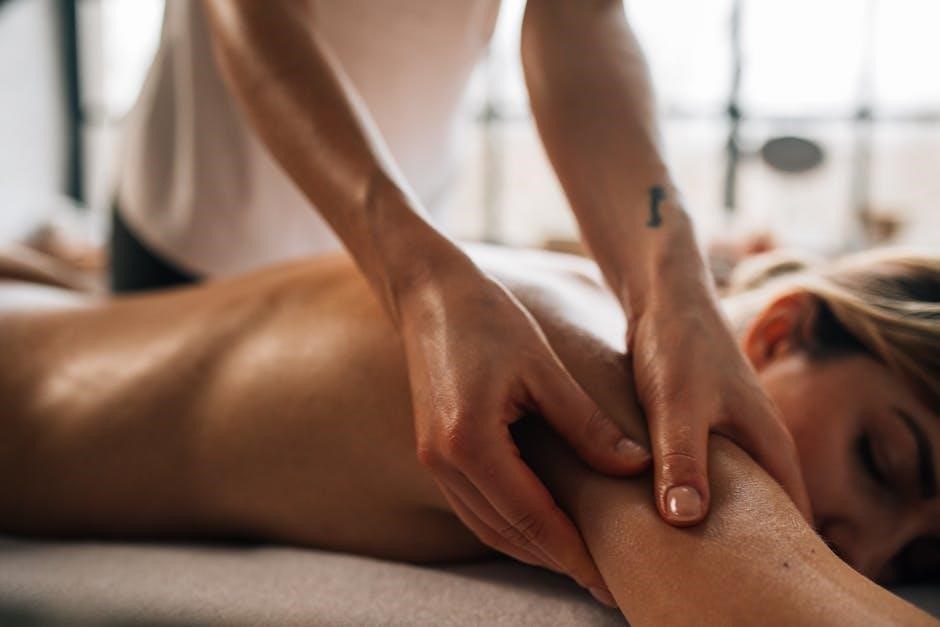
Other Manual Massage Techniques
Manual massage techniques extend beyond Swedish methods, incorporating deep tissue, trigger point therapy, and lymphatic drainage. These specialized approaches target specific areas, addressing chronic pain, muscle knots, and circulatory issues. Techniques like Thai massage and myofascial release also fall under this category, offering diverse benefits for overall wellness and therapeutic relief.
Deep Tissue Massage for Muscle Tension
Deep tissue massage targets the inner layers of muscles and connective tissues to relieve chronic tension and pain. Using slow, deliberate strokes and firm pressure, it focuses on areas like the neck, shoulders, and lower back. This technique helps break up adhesions, improve blood flow, and reduce inflammation. It is particularly effective for addressing conditions such as sciatica, plantar fasciitis, and sports injuries. Regular deep tissue sessions can lead to significant improvements in flexibility and overall muscle function, enhancing mobility and reducing discomfort.
Trigger Point Therapy for Pain Relief
Trigger Point Therapy is a technique that targets specific areas of tension in muscles, known as trigger points, which can cause pain and discomfort. By applying manual pressure to these knotted areas, therapists can release tension, reduce pain, and restore proper muscle function. This method is particularly effective for addressing chronic pain, muscle spasms, and limited mobility. Regular sessions can improve circulation, reduce inflammation, and promote relaxation, making it a valuable approach for managing conditions such as sciatica, fibromyalgia, and sports-related injuries.
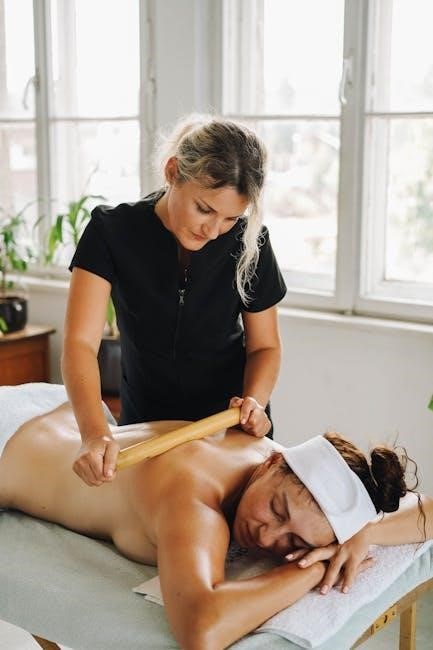
Anatomy and Physiology for Massage Therapists
Understanding the muscular system, bones, and soft tissues is crucial for effective massage. Knowledge of blood circulation and the nervous system aids in promoting healing and relaxation.
Understanding the Muscular System
Understanding the muscular system is essential for massage therapists, as it enables targeted techniques to relieve tension and restore function. Muscles work in groups, with agonists, antagonists, and synergists contributing to movement. Knowledge of muscle origins and insertions helps in identifying trigger points. Proper techniques, such as kneading and friction, can address muscle imbalances and improve flexibility. This foundation ensures effective and safe massage practices, promoting optimal muscle health and client well-being.
The Role of Connective Tissue in Massage
Connective tissue plays a crucial role in massage, as it supports and connects all body structures. Techniques like effleurage and friction target fascia, a type of connective tissue, to release tension and improve circulation. Healthy connective tissue enhances flexibility and posture, while restrictions can lead to pain and limited movement. Massage helps maintain its integrity, promoting relaxation and overall well-being by addressing imbalances in this vital system.
Importance of the Lymphatic System
The lymphatic system is vital for detoxification, immune function, and fluid balance. Massage techniques, such as lymphatic drainage, stimulate lymph flow, enhancing the removal of toxins and boosting immunity. Proper lymphatic function reduces swelling and promotes overall well-being. Understanding its role is essential for effective massage practices, as it directly impacts the body’s ability to heal and maintain health.

Contraindications and Safety Guidelines
Massage is not advised for certain conditions, such as acute injuries, fractures, or infections. Precautions include proper hygiene, avoiding sensitive areas, and ensuring client comfort. Understanding anatomy and pathology is crucial for safe practices.
Conditions Where Massage Is Not Advised
Massage is contraindicated in cases of acute injuries, fractures, or severe inflammation. Conditions like osteoporosis, recent surgeries, or active infections require caution. Deep tissue techniques should be avoided in areas with varicose veins or fragile skin. Additionally, individuals with certain medical conditions, such as severe hypertension or recent deep vein thrombosis, should consult a healthcare provider before receiving massage. Understanding these restrictions ensures safe and effective practice, avoiding potential harm to clients.
Precautions for Safe Massage Practices
Ensure proper sanitation by washing hands and using clean linens. Communicate with clients about medical conditions or discomfort. Avoid applying excessive pressure, especially near fragile areas. Use appropriate oils or lotions to reduce friction; Maintain a comfortable room temperature and privacy. Employ proper body mechanics to prevent strain. Encourage clients to provide feedback during sessions. Avoid massaging areas with open wounds or recent injuries. Stay informed about contraindications and adapt techniques for individual needs. Prioritize client comfort and safety throughout the session.
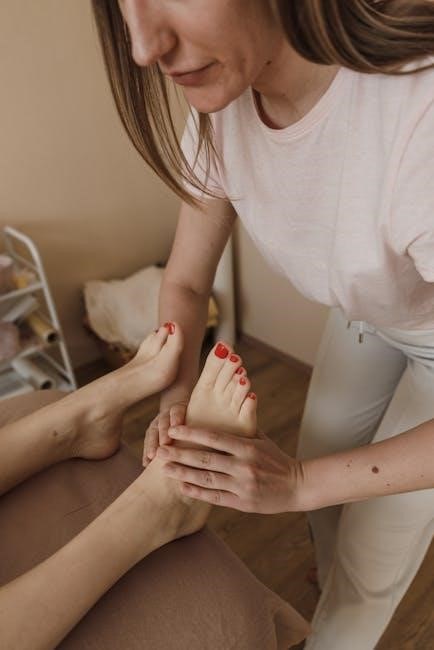
Body Mechanics for Massage Therapists
Proper posture, balance, and using body weight are essential for effective strokes, minimizing strain, and maximizing technique impact in a massage career.
Proper Posture and Alignment
Proper posture and alignment are crucial for massage therapists to ensure effective techniques and prevent physical strain. Maintaining a balanced stance with feet shoulder-width apart and knees slightly bent allows for optimal body mechanics. Keeping the back straight and core engaged supports powerful, controlled movements. By aligning the body correctly, therapists can apply pressure without fatigue, ensuring smooth, therapeutic strokes. This posture also enhances precision, enabling better targeting of muscle groups for maximum relief and client comfort during sessions.
Using Body Weight for Effective Strokes
Using body weight is a key principle in delivering effective massage strokes, allowing therapists to apply deeper pressure without strain. By shifting weight from one foot to the other, practitioners can generate force through their arms and hands, enhancing techniques like effleurage and petrissage. This method ensures consistent pressure, reducing fatigue and improving the client’s experience. Proper body mechanics and weight distribution are essential to maintain control and precision, making strokes more therapeutic and comfortable for the recipient.
Mastering basic massage techniques empowers individuals to enhance well-being, relieve tension, and foster deep relaxation. Continuous practice and proper body mechanics ensure safe, effective, and therapeutic outcomes for all.
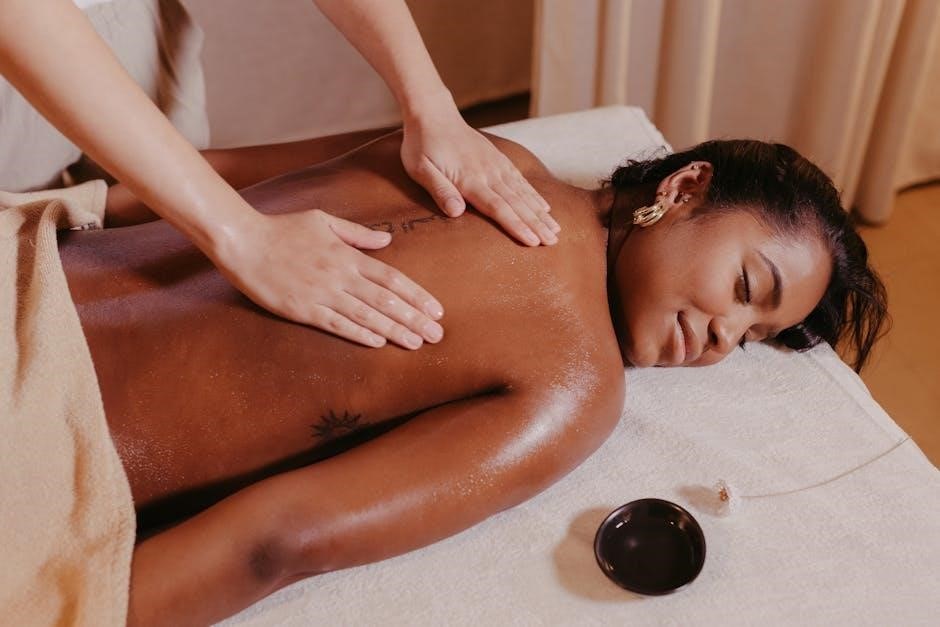
Final Thoughts on Mastering Basic Massage Techniques
Mastering basic massage techniques is a rewarding journey that enhances both personal and professional skills. By understanding fundamentals like effleurage, petrissage, and tapotement, practitioners can deliver effective sessions. Proper body mechanics and knowledge of anatomy ensure safety and efficacy. Regular practice and continuous learning allow for growth and adaptability in addressing various client needs. Ultimately, these techniques offer a holistic approach to wellness, making them invaluable for promoting relaxation, relieving pain, and improving overall well-being in individuals.

